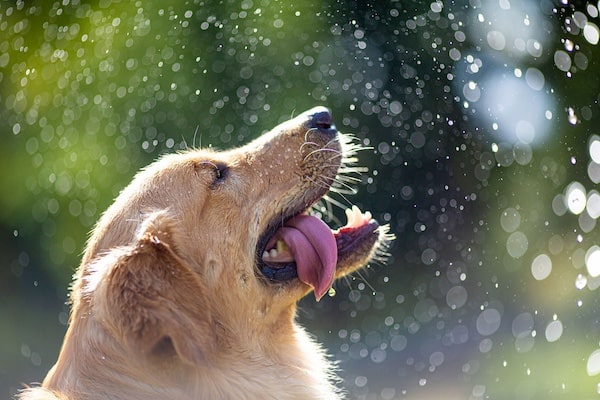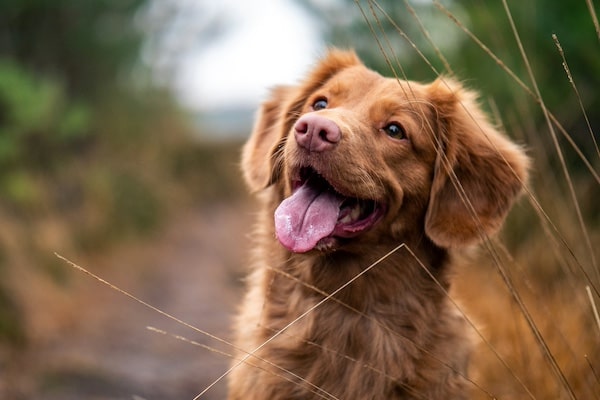Diving into the world of the Nova Scotia Duck Tolling Retriever, this guide offers an in-depth look at a unique and captivating breed. Known affectionately as “Tollers,” these dogs are celebrated for their intelligence, energy, and versatile abilities.
As medium-sized retrievers, they are adept at both luring waterfowl and retrieving game, making them prized among hunting enthusiasts. This guide explores the key traits that define Tollers, from their fiery red coat to their boundless enthusiasm and sharp mind. For those considering adding a Toller to their family, insights into their care, training needs, and compatibility with different lifestyles are provided, ensuring a well-rounded understanding of this remarkable breed.
- Nova Scotia Duck Tolling Retriever – Size & Life Expectancy
- About the Nova Scotia Duck Tolling Retriever
- Traits & Characteristics of the Nova Scotia Duck Tolling Retriever
- Owning a Nova Scotia Duck Tolling Retriever
- The Nova Scotia Duck Tolling Retriever Standard
- Nova Scotia Duck Tolling Retriever – FAQ
- Alternatives to a Nova Scotia Duck Tolling Retriever
Nova Scotia Duck Tolling Retriever – Size & Life Expectancy
Height
18-21 inches (male)
17-20 inches (female)
Weight
35-50 pounds
Life Expectancy
12-14 years
About the Nova Scotia Duck Tolling Retriever
The Nova Scotia Duck Tolling Retriever originated in the early 19th century in Nova Scotia, Canada. This breed was developed to assist hunters by luring ducks and geese within shooting range, a technique known as “tolling”. The Toller’s playful actions along the shoreline mimic the curious movements of a fox, piquing the interest of waterfowl and drawing them closer to the hunter’s blind. The dogs’ ancestors likely included the red decoy dog, various retrievers, and possibly some spaniel breeds, all contributing to the Toller’s keen intelligence, versatility, and striking appearance.
Initially bred by rural communities in Nova Scotia, these dogs were highly valued for their ability to engage in tolling and retrieving without the need for close supervision. Their effectiveness in waterfowl hunting made them indispensable companions in the marshy regions of Canada. Over time, the breed’s reputation spread, and their distinctive method of working continued to win admirers both locally and internationally.
Rise to Popularity
Transitioning from a functional hunter’s tool to a celebrated purebred, the Toller gained official recognition from the Canadian Kennel Club in 1945, a significant milestone that paved the way for wider recognition. By the 1980s, the breed began to establish a presence in the United States and Europe, where their adaptability and spirited disposition found a new audience. Today, the Nova Scotia Duck Tolling Retriever is not only a favorite among hunters but also excels in obedience, agility, and search and rescue, showcasing the breed’s broad range of skills.
In addition to their prowess in sporting and work-related tasks, Tollers have become beloved pets. Their medium size and adaptable nature make them suitable for various living situations, although they thrive best with space to run and play. The breed’s intelligence and eagerness to please allow them to integrate well into family settings, where they often become an integral part of daily activities.
The Toller Today
As of today, the Nova Scotia Duck Tolling Retriever enjoys a modest but dedicated following around the world. They rank in the middle range of popularity among breeds recognized by major kennel clubs, reflecting a balanced blend of enthusiasts drawn to either their sporting capabilities or their charismatic companionship. The Toller’s appeal lies in its dual role as a tireless working dog and a loyal family member.
Typical owners are those who appreciate a high-energy dog that requires regular, vigorous exercise and mental stimulation. The breed is particularly suited to active individuals or families who enjoy outdoor activities and are prepared to engage with a dog that is both intelligent and sometimes willfully mischievous. Owners need to commit to consistent training and socialization, as the Toller’s sharp mind can lead to clever, sometimes stubborn behavior if not properly directed.
Conclusively, the Nova Scotia Duck Tolling Retriever stands out as a testament to skilled breeding and the enduring appeal of a working dog that seamlessly transitions into a loving pet. Whether tolling in the chilly waters of Nova Scotia or fetching a ball in a sunny suburban backyard, the Toller continues to captivate and charm dog lovers around the globe.
Traits & Characteristics of the Nova Scotia Duck Tolling Retriever
- Medium-sized: Typically weighing between 35 to 50 pounds.
- High energy: Requires regular, vigorous exercise.
- Intelligent and trainable: Quick to learn and eager to please, making them excellent for obedience and agility training.
- Playful demeanor: Known for their playful behavior, which is essential in their traditional role in tolling.
- Affectionate with families: Very loyal and bonds closely with their owners.
- Strong retrieving instincts: Natural retrievers, both on land and in water.
- Adaptable: Can live in a variety of settings but does best with space to run and play.
Owning a Nova Scotia Duck Tolling Retriever
If you’re considering the Nova Scotia Duck Tolling Retriever as your next canine companion, you’re looking at a breed that brings both joy and vigor to everyday life. Known for their distinctive red coat and boundless energy, Tollers are as adept at working tasks as they are at being loyal family pets. This guide provides insights into essential aspects of caring for a Toller, from health and exercise to grooming, nutrition, and training.
Health
Nova Scotia Duck Tolling Retrievers are generally robust dogs with a life expectancy of 12 to 14 years. However, like many purebred dogs, they are prone to certain health conditions. Common issues include hip dysplasia, progressive retinal atrophy, and autoimmune thyroiditis. It is crucial for owners to maintain regular veterinary check-ups that can help catch and manage these issues early on. Additionally, genetic testing is advised for breeders to help reduce the incidence of inheritable conditions. Maintaining a healthy weight is also key to mitigating the risk of joint problems and enhancing overall vitality.
Exercise
Tollers are high-energy dogs that thrive on physical activity. They require at least an hour of vigorous exercise daily to keep them both physically and mentally stimulated. Ideal activities include running, fetching, and swimming—activities that tap into their retrieving instincts and love for water. Agility training can also be a great way to channel their energy and intelligence. Owners should provide regular, structured opportunities for exercise to prevent behavioral issues that stem from boredom and excess energy.
Grooming
The Toller’s coat is medium-length and water-repellent, with a soft, dense undercoat and a harsher outer coat. They shed moderately throughout the year and more heavily during seasonal changes. Weekly brushing is recommended to remove loose hair and prevent matting. During shedding season, more frequent grooming might be necessary to manage the increased hair loss. The Toller’s ears should be checked regularly for signs of infection, especially given their love for swimming. Regular nail trimming and dental care should also be part of their grooming routine to prevent overgrowth and oral issues.
Nutrition
The right diet is crucial for a Toller’s health and wellbeing. A balanced diet that suits their age, weight, and energy level is essential. High-quality commercial dog food that meets the nutritional levels established by the AAFCO is a good baseline. Foods rich in proteins and fats are beneficial for their energetic lifestyle, but it’s important to avoid overfeeding, especially foods high in calories or unhealthy treats. Foods to avoid include those with toxic ingredients for dogs, such as chocolate, grapes, and xylitol. Consultation with a veterinarian can provide tailored nutritional advice, particularly if your Toller has specific health concerns.
Training
Nova Scotia Duck Tolling Retrievers are highly intelligent and generally easy to train. They respond well to positive reinforcement techniques such as treats and praise. Early puppy training and socialization are essential to harness their potential and to prevent the development of shy or aggressive behaviors. Socialization should include exposure to a variety of people, sounds, and experiences. Regular, consistent training sessions help Tollers understand what is expected of them and strengthen their bond with their owners. Advanced training in obedience, agility, or field work can also provide excellent mental stimulation and reinforce good behavior.
Caring for a Toller requires commitment, but the rewards of companionship, loyalty, and shared activity make it a fulfilling endeavor for those willing to meet their needs.
The Nova Scotia Duck Tolling Retriever Standard
The Nova Scotia Duck Tolling Retriever is distinguished not only by its robust abilities as a retriever and toller but also by a breed standard that outlines the physical and behavioral ideals. These standards are essential for judging the breed in competitive shows and ensuring that the qualities that make the Toller both effective and endearing are preserved and propagated.
General Appearance
The ideal Toller is a medium-sized, powerful dog, well-balanced and with a compact build that suggests strength and agility. The breed carries a proud posture, with a slightly wedge-shaped head and alert, expressive eyes that convey intelligence and eagerness. The body is slightly longer than it is tall, exhibiting a deep chest and well-muscled hindquarters, ready for bursts of speed and agile maneuvers.
Coat and Color
The coat is of medium length, soft yet water-resistant, with a softer and dense undercoat that provides insulation. The outer coat is straight and may have a slight wave, offering protection from harsh weather conditions. Tollers are primarily recognized by their rich, reddish-orange color, with white markings on the chest, feet, tail tip, and occasionally on the face and blaze. The vibrancy of the red coat is a hallmark of the breed, designed to catch the eye both in the field and in the show ring.
Head
The head of the Toller is well-proportioned to its body, with a clean-cut skull and a strong, broad muzzle. Ears are set high and are triangular, hanging close to the head with a slight lift at the base when alert. Eyes should be almond-shaped, medium-sized, and usually amber to brown in color, reflecting an intelligent and friendly expression. A correct bite, either scissors or level, is crucial for a dog bred for retrieving.
Tail and Movement
The tail is another distinctive feature, carried jauntily when in motion but never curled over the back. It serves as a powerful rudder during swimming. Movement is of paramount importance; the Toller’s gait should be effortless and should cover ground with good drive and reach, displaying the breed’s inherent agility and stamina.
Temperament
Behaviorally, the Toller is outgoing and affectionate, yet with an underlying reserve, especially around strangers. This breed thrives on work and play, demonstrating an insatiable desire to hunt and retrieve. Yet, a well-bred Toller should be equally capable of calm and composure when out of the field, making them excellent companions as well as competitors.
Adhering to these breed standards helps ensure that the Nova Scotia Duck Tolling Retriever not only looks the part of a capable, beautiful sporting dog but also behaves as one. Judges at dog shows evaluate Tollers against these criteria, aiming to select dogs that exemplify the best of the breed, both in form and function. This meticulous attention to the breed standard protects the integrity of the Toller and guarantees its future as a remarkable retriever.
Nova Scotia Duck Tolling Retriever – FAQ
Explore essential insights about the Nova Scotia Duck Tolling Retriever with our comprehensive FAQ. Whether you’re a potential owner or simply curious about this lively breed, find answers to common questions about their characteristics, care requirements, and suitability as family pets right here.
Alternatives to a Nova Scotia Duck Tolling Retriever
Several dog breeds share similarities in size, traits, and characteristics with the Nova Scotia Duck Tolling Retriever. Each breed, while unique, exhibits comparable qualities such as intelligence, energy, and a love for water-related activities.
The Golden Retriever stands as a classic comparison. Similar in their friendly and intelligent disposition, Golden Retrievers are slightly larger but share the Toller’s enthusiasm for retrieving and water. Both breeds excel in obedience and agility, making them favorites for families and sports enthusiasts alike.
The Labrador Retriever also mirrors the Toller in many respects. Known for their trainability and gentle nature, Labradors are slightly more robust but equally adept at water retrieving and are commonly used in similar roles such as hunting dogs and service animals.
The Brittany, while a member of the spaniel family, shows a comparable zest for life and activity levels. Smaller and more agile, Brittanys are excellent hunters with a keen sense of smell and a readiness to please, much like the Toller.
The English Springer Spaniel is another breed that aligns closely with the Toller’s characteristics. Known for their boundless energy and affectionate nature, Springers share the Toller’s medium build and proficiency in fieldwork.
Lastly, the American Water Spaniel, though rarer, provides a similar size and skill set, thriving in water and field activities and known for a curly coat that, like the Toller’s, serves them well in aquatic environments.
These breeds, while each possessing unique traits, align closely with the Nova Scotia Duck Tolling Retriever in their shared heritage of fieldwork, love for water, and engaging personalities.





